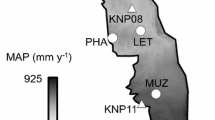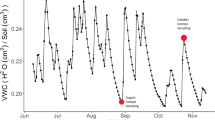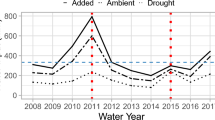Abstract
Stable isotope analysis was used to determine sources of water used by coexisting trees and grasses in a temperate savanna dominated by Quercus emoryi Torr. We predicted that (1) tree seedlings and bunchgrasses utilize shallow sources of soil water, (2) mature savanna trees use deeper sources of water, and (3) trees switch from shallow to deep water sources within 1 year of germination. We found that Q. emoryi trees, saplings, and seedlings (about 2 months, 1 year, and 2 years old), and the dominant bunchgrass [Trachypogon montufari (H.B.K.) Nees.] utilized seasonally available moisture from different depths within the soil profile depending on size/age relationships. Sapling and mature Q. emoryi acquired water from >50 cm deep, 2-month-old seedlings utilized water from <15 cm, and 1- and 2-year-old seedlings and grasses used water from between 20 cm and 35 cm. This suggests that very young seedlings are decoupled from grasses in this system, which may facilitate germination and early establishment of Q. emoryi within extant stands of native grasses. The potential for subsequent interaction between Q. emoryi and native grasses was evidenced by similar patterns of soil water use by 1- and 2-year-old seedlings and grasses. Q. emoryi seedlings did not switch from shallow to deep sources of soil water within 2 years of germination: water use by these seedlings apparently becomes independent of water use by grasses after 2 years of age. Finally, older trees (saplings, mature trees) use water from deeper soil layers than grasses, which may facilitate the stable coexistence of mature trees and grasses. Potential shifts in the seasonality of precipitation may alter interactions between woody plants and grasses within temperate savannas characterized by bimodal precipitation regimes: reductions in summer precipitation or soil moisture may be particularly detrimental to warm-season grasses and seedlings of Q. emoryi.
Similar content being viewed by others
Author information
Authors and Affiliations
Additional information
Received: 21 November 1996 / Accepted: 2 May 1997
Rights and permissions
About this article
Cite this article
Weltzin, J., McPherson, G. Spatial and temporal soil moisture resource partitioning by trees and grasses in a temperate savanna, Arizona, USA. Oecologia 112, 156–164 (1997). https://doi.org/10.1007/s004420050295
Issue Date:
DOI: https://doi.org/10.1007/s004420050295




